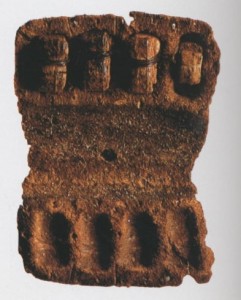Phylacteries, Mezuzot and Bibles
A distinct area of halakhah is that of scribal practice. Here it seems clear that much of the scribal art transcended sectarian religious affiliation. This would explain why scribal law in rabbinic texts and indeed in later Jewish tradition is so close to that found when we investigate the actual artifacts–the Dead Sea Scrolls and other biblical texts from the Judean desert. Without going into details here, rabbinic Judaism received a scribal tradition from the earlier Jewish community and, for the most part, simply passed it down, following virtually the same mechanics for the production of hides, their preparation, writing, and the storage of scrolls.
Further, if we investigate the mezuzot and phylacteries, we can see the intersection of the common scribal arts with the varying interpretations regarding the contents. Apparently, the sectarians were willing to include passages from before and after those required by the Pharisaic-rabbinic tradition, which limited itself and did not allow any additional material.
But the commonality in the preparation and construction of phylacteries, for example, and in the practice of mezuzah, shows clearly that these were elements inherited from the common Judaism of second Temple times. This is the case despite the fact that rabbinic traditions connect these religious objects closely to oral law, an approach eschewed by the Qumran sectarians and other Sadducee/Zadokites.
But of course the second Temple biblical materials contrast greatly with rabbinic statements on the subject and with what seems to be the evidence of Pharisaic influence at Masada and in the bar Kokhba caves. Rabbinic texts assume a much greater standardization of the biblical text than what is in evidence in the Qumran materials and in the secondary use of biblical material in the scrolls.
Further, the Septuagint and the use of biblical materials in the Apocrypha and pseudepigrapha often support the looser construction of biblical texts known to us from Qumran where a variety of texts and text types coexisted. While clearly this is in contrast to what we have observed in rabbinic texts, despite some textual variants in biblical materials preserved there, we cannot be totally certain that Pharisaic Jews in second Temple times would have had Bibles as standard as those assumed by the Mishnah and Talmud. Josephus does write as though this is the case, in the last part of the first century C.E., but it is not possible for us to be certain about the Pharisees of the early period.


Leave a Reply